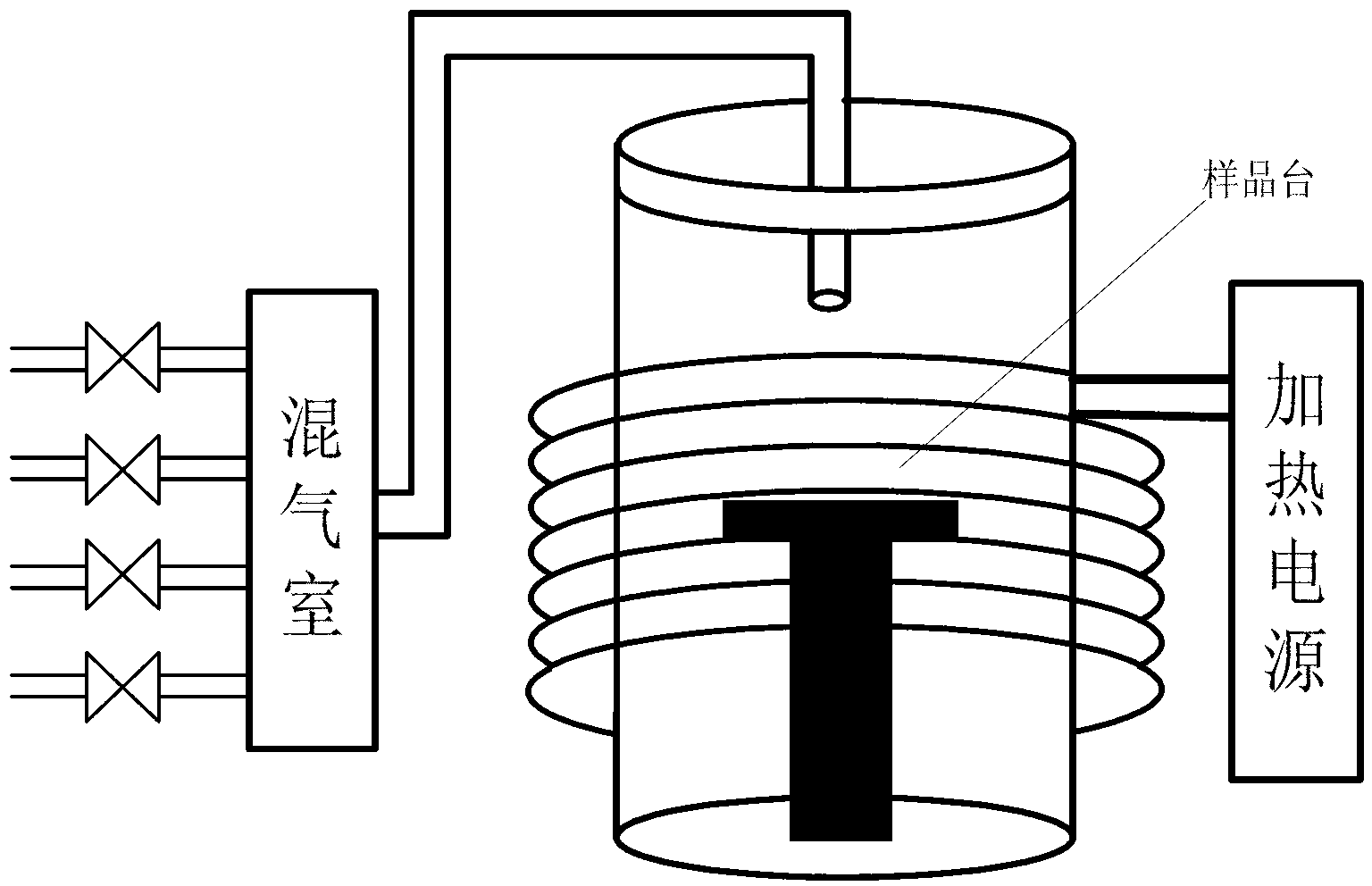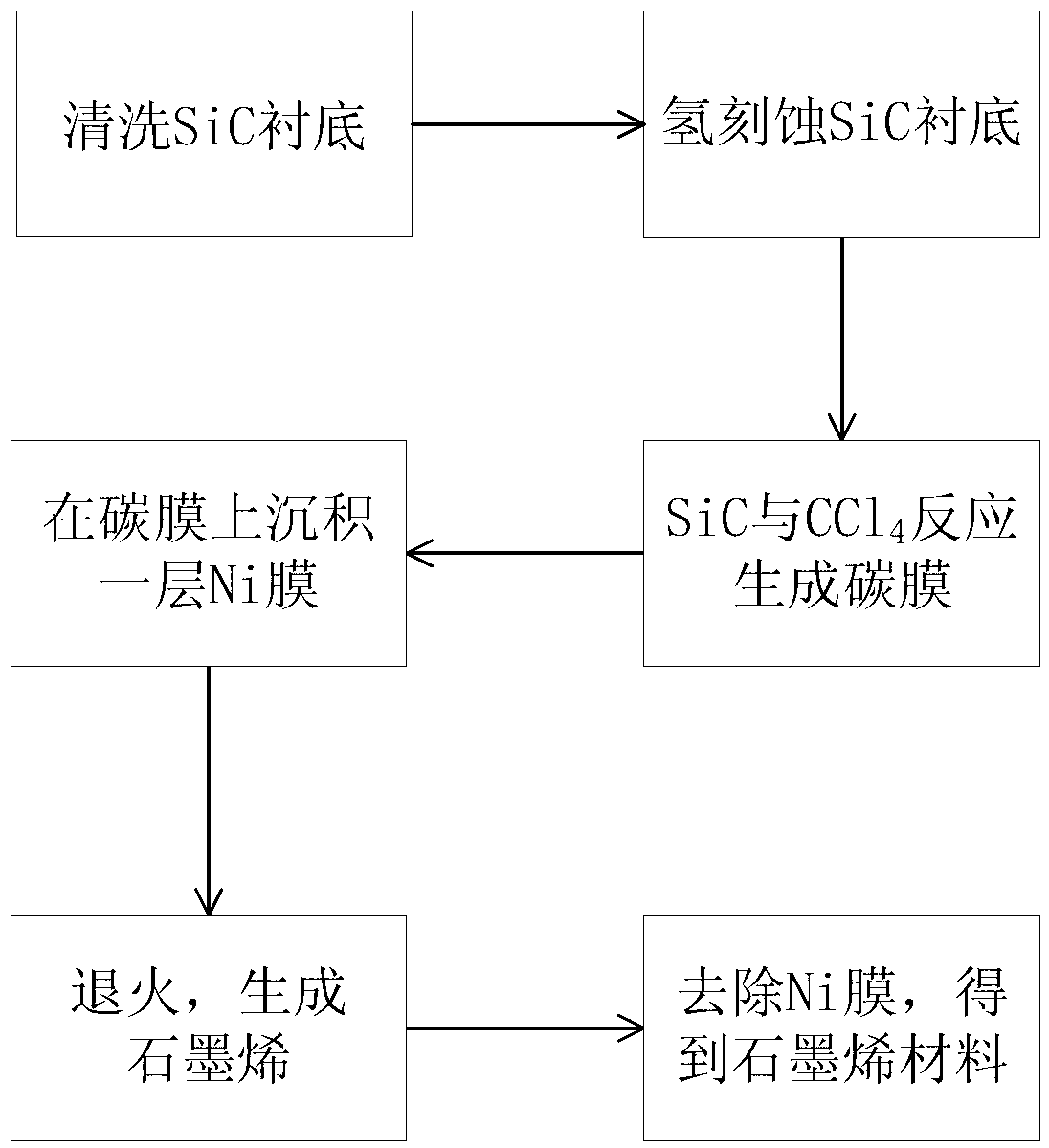Preparation method of large-area graphene on SiC substrate based on Ni film annealing
A graphene and large-area technology, applied in the field of microelectronics, can solve the problems of unstable carrier mobility, small graphene area, uneven layer number, etc., and achieve less defects, low porosity, and good continuity Effect
- Summary
- Abstract
- Description
- Claims
- Application Information
AI Technical Summary
Problems solved by technology
Method used
Image
Examples
Embodiment 1
[0037] Example 1, using 6H-SiC as a substrate to grow graphene material.
[0038] Step 1: Clean the 6H-SiC substrate with a mixed solution of ammonia water and hydrogen peroxide, and a mixed solution of hydrochloric acid and hydrogen peroxide in sequence.
[0039] (1.1) According to NH 4 OH:H 2 o 2 :H 2 Prepare a solution at a ratio of O=1:2:5, place the 6H-SiC substrate in the solution, soak for 10 minutes, rinse with deionized water repeatedly and then dry to remove organic residues on the surface of the sample;
[0040] (1.2) According to HCl: H 2 o 2 :H 2 The solution was prepared at a ratio of O=1:2:8, and the 6H-SiC substrate after removing the surface organic residues was placed in the solution, soaked for 10 minutes, rinsed repeatedly with deionized water and then dried to remove ionic pollutants .
[0041] The second step: performing hydrogen etching treatment on the cleaned 6H-SiC substrate, and removing the formed Si compound.
[0042] (2.1) Put the cleaned...
Embodiment 2
[0051] Example 2, using 4H-SiC as a substrate to grow graphene materials:
[0052] Step 1: Clean the 4H-SiC substrate with a mixed solution of ammonia water and hydrogen peroxide, and a mixed solution of hydrochloric acid and hydrogen peroxide in sequence.
[0053] This step is the same as the first step in Example 1.
[0054] Step 2: perform hydrogen etching on the cleaned 4H-SiC substrate, and remove the formed Si compound.
[0055] (2.1) Put the cleaned 4H-SiC substrate into the graphene growth equipment, turn on the heating power, heat the reaction chamber to 1600°C, open the vent valve, and let in H2 with a flow rate of 80L / min. 2 , perform 30min hydrogen etching on the 4H-SiC substrate to remove scratches and defects on the surface of the 4H-SiC substrate;
[0056] (2.2) After hydrogen etching is completed, adjust the heating power supply voltage, cool down to 1000°C, and pass in hydrogen with a flow rate of 3L / min for 15 minutes; then cool down to 850°C, and pass in S...
Embodiment 3
[0064] Example 3, using 4H-SiC as a substrate to grow graphene material.
[0065] Step A: cleaning the 4H-SiC substrate with a mixed solution of ammonia water and hydrogen peroxide, and a mixed solution of hydrochloric acid and hydrogen peroxide in sequence.
[0066] This step is the same as the first step in Example 1.
[0067] Step B: carry out the hydrogen etching process first: put the cleaned 4H-SiC substrate into the graphene growth equipment, turn on the heating power supply, heat the reaction chamber to 1600°C, open the ventilation valve, and feed the gas with a flow rate of 100L / min h 2 , perform 60min hydrogen etching on the 4H-SiC substrate to remove scratches and defects on the surface of the 4H-SiC substrate;
[0068] Then remove the compound produced by hydrogen etching: after the hydrogen etching is completed, adjust the heating power supply voltage, lower the temperature to 1000°C, and pass in hydrogen at a flow rate of 4L / min for 15 minutes; then cool down t...
PUM
 Login to View More
Login to View More Abstract
Description
Claims
Application Information
 Login to View More
Login to View More - R&D
- Intellectual Property
- Life Sciences
- Materials
- Tech Scout
- Unparalleled Data Quality
- Higher Quality Content
- 60% Fewer Hallucinations
Browse by: Latest US Patents, China's latest patents, Technical Efficacy Thesaurus, Application Domain, Technology Topic, Popular Technical Reports.
© 2025 PatSnap. All rights reserved.Legal|Privacy policy|Modern Slavery Act Transparency Statement|Sitemap|About US| Contact US: help@patsnap.com


